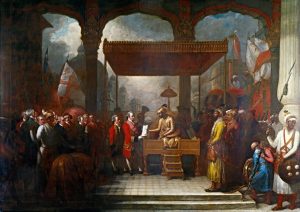Introduction – Treaty of Allahabad
The Seven Year’s War was one of the first European conflicts with theatres around the world. In India – much like North America – French and British trading companies had been vying for control and influence for several decades. Their increasing commercial influence overlapped with the decline of the Mughal Empire and – like in North America – by the 1740s, there was widespread imperial violence; known locally as the Carnatic Wars.
Different from North America, however, was the role in the conflict of private companies. With no settlers on the ground, the French and British presence in India was indirect, through the Compagnie française pour le commerce des Indes orientales and the British East India Company. Unlike companies today, these corporations had extensive powers, raising mostly Indian troops and – increasingly over time – formally representing their respective crowns.
The Carnatic Wars were a series of conflicts where these companies and local Indian rulers vied for power and key trading locations. Sparked by British belligerence during the War of Austrian Succession (the Companies had initially agreed to peace), by the end of that war, conflict in India continued, while Europe saw a brief peace; the second Carnatic War took place between the War of Austrian Succession and the Seven Year’s War. During the third war – which overlapped exactly with the Seven Year’s War – the British East India Company gained the upper hand, capturing key French trading factories at Chandenagore and Pondichéry. Though the French right to trade from these ports was returned in 1763, French administration of the ports was banned.
Though the fighting had ended between Europeans, these wars were not solely European affairs. The British East India Company continued to fight the remnants of the Mughal Empire. In Bengal, in 1764, Company forces roundly defeated the Mughal army, removing much of the political opposition along the Ganges River. The Treaty of Allahabad is the agreement made following this battle between the Mughal Emperor Shah Alam II and British East India Company officer Robert Clive. As you read through it, consider the following questions:
- What are the basic terms of this treaty?
- How does this agreement position the British East India Company in the region?

This chapter was modified in December 2021.

